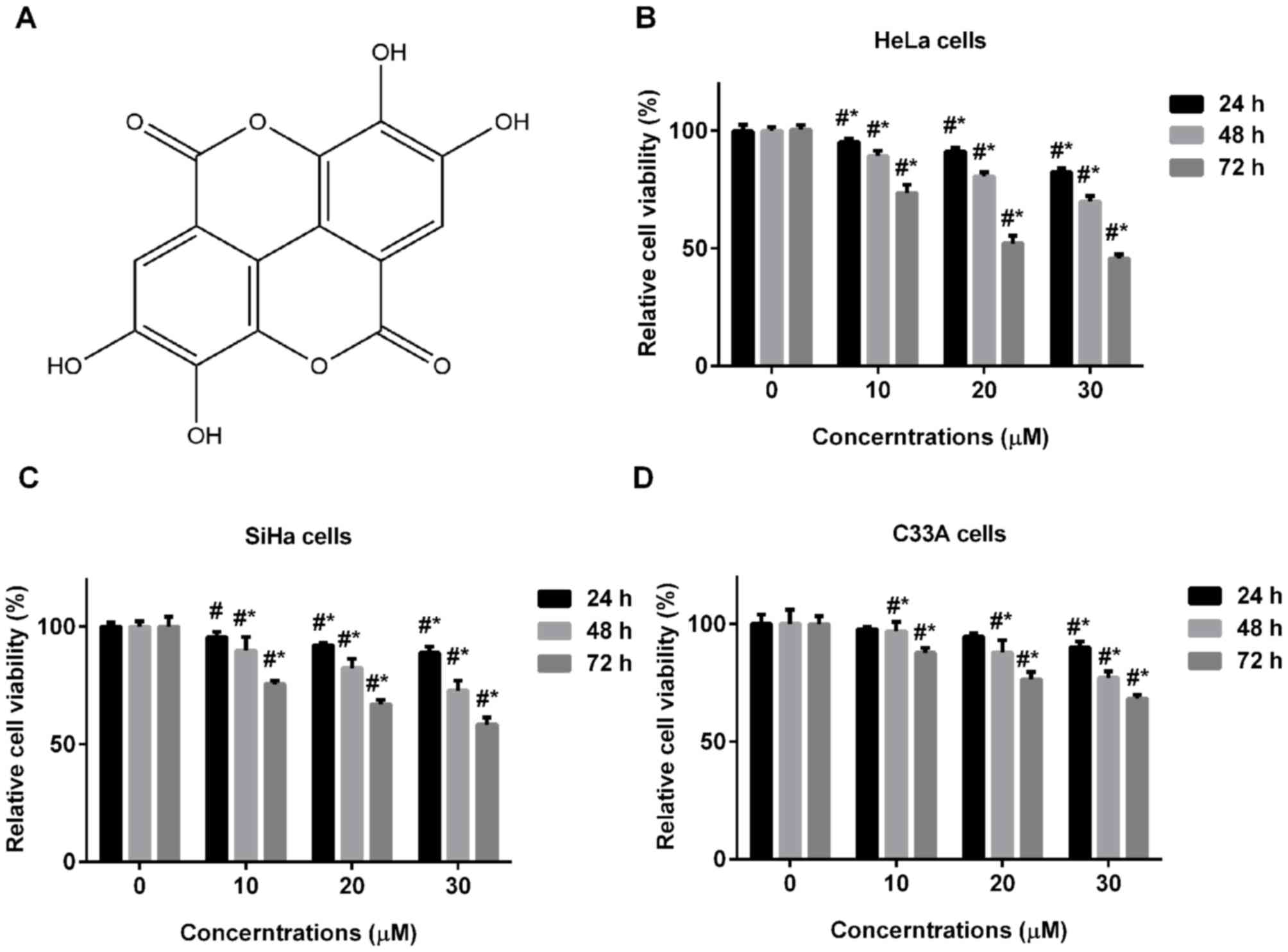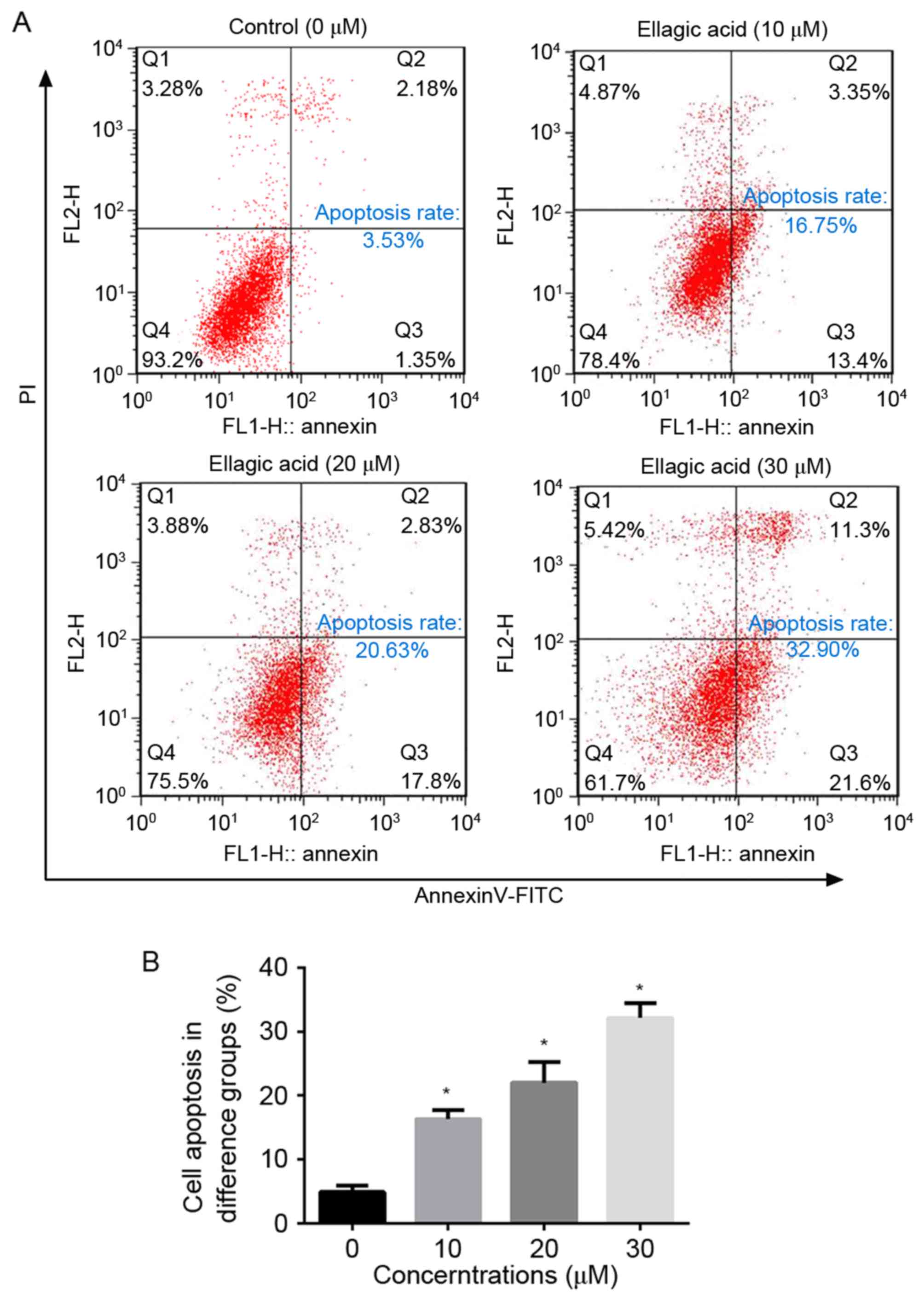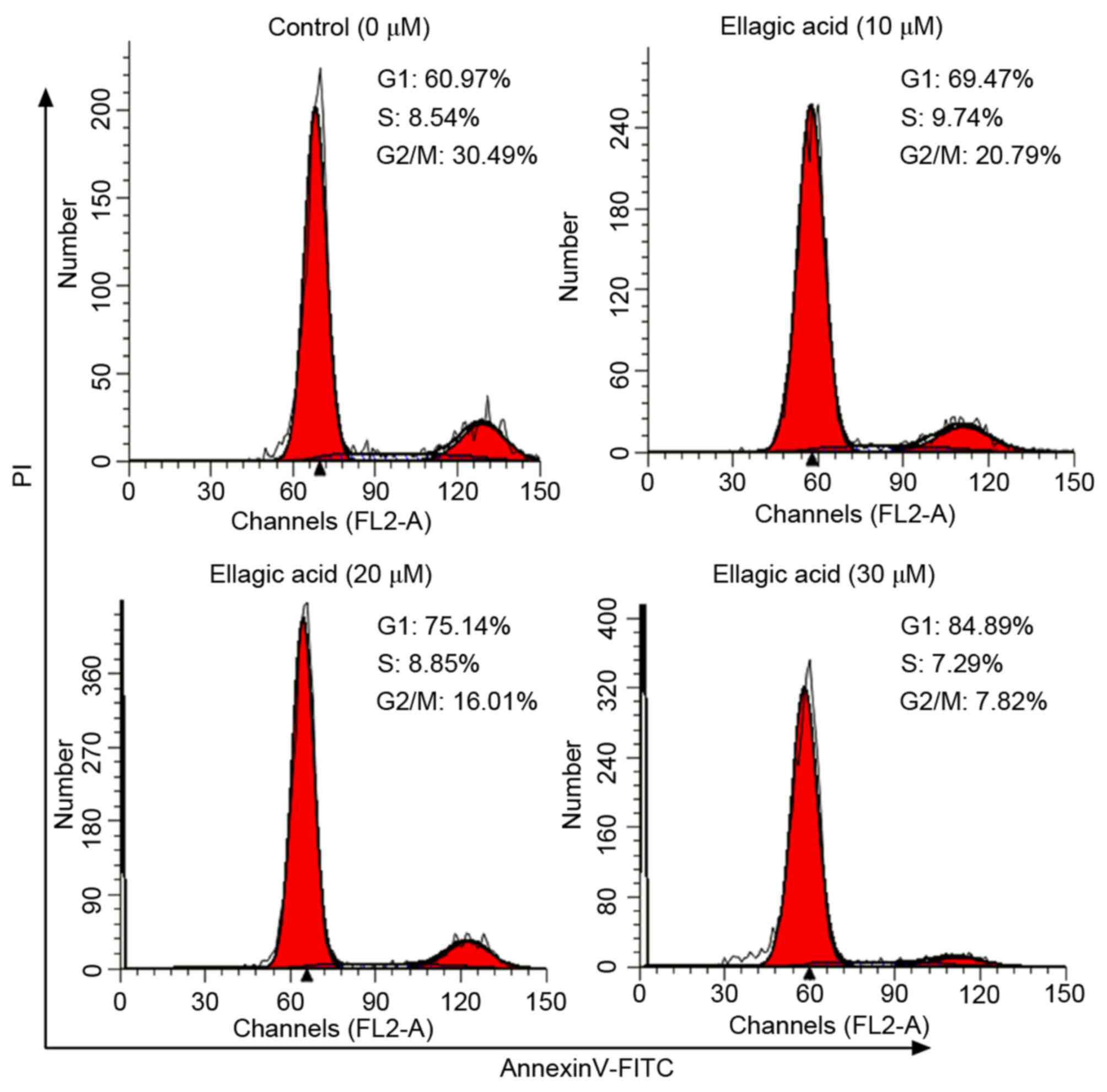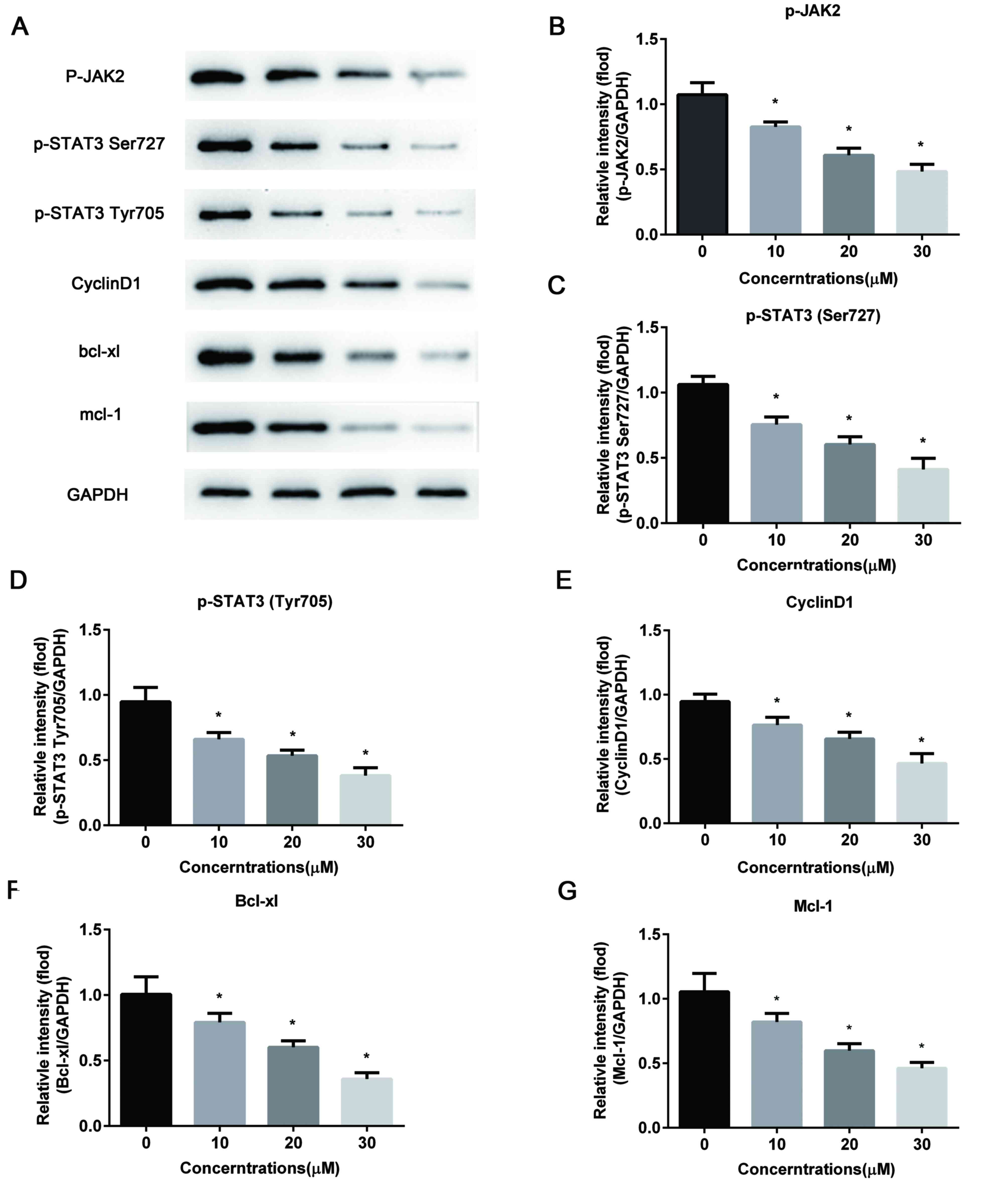|
1
|
Ferlay J, Soerjomataram I, Dikshit R, Eser
S, Mathers C, Rebelo M, Parkin DM, Forman D and Bray F: Cancer
incidence and mortality worldwide: Sources, methods and major
patterns in GLOBOCAN 2012. Int J Cancer. 136:E359–E386. 2015.
View Article : Google Scholar : PubMed/NCBI
|
|
2
|
Torre LA, Bray F, Siegel RL, Ferlay J,
Lortet-Tieulent J and Jemal A: Global cancer statistics, 2012. CA:
a cancer journal for clinicians. 65:87–108. 2015.PubMed/NCBI
|
|
3
|
Liu J, Sun Y, Zhang H, Ji D, Wu F, Tian H,
Liu K, Zhang Y, Wu B and Zhang G: Theanine from tea and its
semi-synthetic derivative TBrC suppress human cervical cancer
growth and migration by inhibiting EGFR/Met-Akt/NF-κB signaling.
Eur J Pharmacol. 791:297–307. 2016. View Article : Google Scholar : PubMed/NCBI
|
|
4
|
Munagala R, Aqil F, Jeyabalan J and Gupta
RC: Tanshinone IIA inhibits viral oncogene expression leading to
apoptosis and inhibition of cervical cancer. Cancer Lett.
356:536–546. 2015. View Article : Google Scholar : PubMed/NCBI
|
|
5
|
Kim B, Kim HS, Jung EJ, Lee JYBKT, Lim JM
and Song YS: Curcumin induces ER stress-mediated apoptosis through
selective generation of reactive oxygen species in cervical cancer
cells. Mol Carcinog. 55:918–928. 2016. View
Article : Google Scholar : PubMed/NCBI
|
|
6
|
Promsong A, Chung WO, Satthakarn S and
Nittayananta W: Ellagic acid modulates the expression of oral
innate immune mediators: Potential role in mucosal protection. J
Oral Pathol Med. 44:214–221. 2015. View Article : Google Scholar : PubMed/NCBI
|
|
7
|
Seo CS, Jeong SJ, Yoo SR, Lee NR and Shin
HK: Quantitative analysis and in vitro anti-inflammatory effects of
gallic acid, ellagic acid, and quercetin from radix sanguisorbae.
Pharmacogn Mag. 12:104–108. 2016. View Article : Google Scholar : PubMed/NCBI
|
|
8
|
Baek B, Lee SH, Kim K, Lim HW and Lim CJ:
Ellagic acid plays a protective role against UV-B-induced oxidative
stress by up-regulating antioxidant components in human dermal
fibroblasts. Korean J Physiol Pharmacol. 20:269–277. 2016.
View Article : Google Scholar : PubMed/NCBI
|
|
9
|
Park SW, Kwon MJ, Yoo JY, Choi HJ and Ahn
YJ: Antiviral activity and possible mode of action of ellagic acid
identified in Lagerstroemia speciosa leaves toward human
rhinoviruses. BMC Complement Altern Med. 14:1712014. View Article : Google Scholar : PubMed/NCBI
|
|
10
|
Zhao M, Tang S-N, Marsh JL, Shankar S and
Srivastava RK: Ellagic acid inhibits human pancreatic cancer growth
in Balb c nude mice. Cancer Lett. 337:210–217. 2013. View Article : Google Scholar : PubMed/NCBI
|
|
11
|
Ho CC, Huang AC, Yu CS, Lien JC, Wu SH,
Huang YP, Huang HY, Kuo JH, Liao WY, Yang JS, et al: Ellagic acid
induces apoptosis in TSGH8301 human bladder cancer cells through
the endoplasmic reticulum stress- and mitochondria-dependent
signaling pathways. Environ Toxicol. 29:1262–1274. 2014.PubMed/NCBI
|
|
12
|
Hagiwara Y, Kasukabe T, Kaneko Y, Niitsu N
and Okabe-Kado J: Ellagic acid, a natural polyphenolic compound,
induces apoptosis and potentiates retinoic acid-induced
differentiation of human leukemia HL-60 cells. Int J Hematol.
92:136–143. 2010. View Article : Google Scholar : PubMed/NCBI
|
|
13
|
Wang N, Wang ZY, Mo SL, Loo TY, Wang DM,
Luo HB, Yang DP, Chen YL, Shen JG and Chen JP: Ellagic acid, a
phenolic compound, exerts anti-angiogenesis effects via VEGFR-2
signaling pathway in breast cancer. Breast Cancer Res Treat.
134:943–955. 2012. View Article : Google Scholar : PubMed/NCBI
|
|
14
|
Narayanan BA, Geoffroy O, Willingham MC,
Re GG and Nixon DW: p53/p21(WAF1/CIP1) expression and its possible
role in G1 arrest and apoptosis in ellagic acid treated cancer
cells. Cancer Lett. 136:215–221. 1999. View Article : Google Scholar : PubMed/NCBI
|
|
15
|
Eskandari E, Heidarian E, Amini SA and
Saffari-Chaleshtori J: Evaluating the effects of ellagic acid on
pSTAT3, pAKT, and pERK1/2 signaling pathways in prostate cancer PC3
cells. J Cancer Res Ther. 2016.
|
|
16
|
Siveen KS, Sikka S, Surana R, Dai X, Zhang
J, Kumar AP, Tan BK, Sethi G and Bishayee A: Targeting the STAT3
signaling pathway in cancer: Role of synthetic and natural
inhibitors. Biochim Biophys Acta. 1845:136–154. 2014.PubMed/NCBI
|
|
17
|
Yu H, Lee H, Herrmann A, Buettner R and
Jove R: Revisiting STAT3 signalling in cancer: new and unexpected
biological functions. Nat Rev Cancer. 14:736–746. 2014. View Article : Google Scholar : PubMed/NCBI
|
|
18
|
Shukla S, Shishodia G, Mahata S, Hedau S,
Pandey A, Bhambhani S, Batra S, Basir SF, Das BC and Bharti AC:
Aberrant expression and constitutive activation of STAT3 in
cervical carcinogenesis: Implications in high-risk human
papillomavirus infection. Mol Cancer. 9:2822010. View Article : Google Scholar : PubMed/NCBI
|
|
19
|
Chen CL, Hsieh FC, Lieblein J, Brown J,
Chan C, Wallace J, Cheng G, Hall B and Lin J: Stat3 activation in
human endometrial and cervical cancers. Brit J Cancer. 96:591–599.
2007. View Article : Google Scholar : PubMed/NCBI
|
|
20
|
Ren C, Cheng X, Lu B and Yang G:
Activation of interleukin-6/signal transducer and activator of
transcription 3 by human papillomavirus early proteins 6 induces
fibroblast senescence to promote cervical tumourigenesis through
autocrine and paracrine pathways in tumour microenvironment. Eur J
Cancer. 49:3889–3899. 2013. View Article : Google Scholar : PubMed/NCBI
|
|
21
|
Sobti R, Singh N, Hussain S, Suri V,
Bharti A and Das B: Overexpression of STAT3 in HPV-mediated
cervical cancer in a north Indian population. Mol Cell Biochem.
330:193–199. 2009. View Article : Google Scholar : PubMed/NCBI
|
|
22
|
Zellner A, Meixensberger J, Roggendorf W,
Janka M, Hoehn H and Roosen K: DNA ploidy and cell-cycle analysis
in intracranial meningiomas and hemangiopericytomas: a study with
high-resolution DNA flow cytometry. Int J Cancer. 79:116–20. 1998.
View Article : Google Scholar : PubMed/NCBI
|
|
23
|
Engelke LH, Hamacher A, Proksch P and
Kassack MU: Ellagic acid and resveratrol prevent the development of
cisplatin resistance in the epithelial ovarian cancer cell line
A2780. J Cancer. 7:353–363. 2016. View Article : Google Scholar : PubMed/NCBI
|
|
24
|
Edderkaoui M, Odinokova I, Ohno I,
Gukovsky I, Go VL, Pandol SJ and Gukovskaya AS: Ellagic acid
induces apoptosis through inhibition of nuclear factor kappa B in
pancreatic cancer cells. World J Gastroenterol. 14:3672–3680. 2008.
View Article : Google Scholar : PubMed/NCBI
|
|
25
|
Salimi A, Roudkenar MH, Sadeghi L, Mohseni
A, Seydi E, Pirahmadi N and Pourahmad J: Ellagic acid, a
polyphenolic compound, selectively induces ROS-mediated apoptosis
in cancerous B-lymphocytes of CLL patients by directly targeting
mitochondria. Redox Biol. 6:461–471. 2015. View Article : Google Scholar : PubMed/NCBI
|
|
26
|
Kumar D, Basu S, Parija L, Rout D, Manna
S, Dandapat J and Debata PR: Curcumin and Ellagic acid
synergistically induce ROS generation, DNA damage, p53 accumulation
and apoptosis in HeLa cervical carcinoma cells. Biomed
Pharmacother. 81:31–37. 2016. View Article : Google Scholar : PubMed/NCBI
|
|
27
|
Chen HS, Bai MH, Zhang T, Li GD and Liu M:
Ellagic acid induces cell cycle arrest and apoptosis through
TGF-β/Smad3 signaling pathway in human breast cancer MCF-7 cells.
Int J Oncol. 46:1730–1738. 2015. View Article : Google Scholar : PubMed/NCBI
|
|
28
|
Chung YC, Lu LC, Tsai MH, Chen YJ, Chen
YY, Yao SP and Hsu CP: The inhibitory effect of ellagic Acid on
cell growth of ovarian carcinoma cells. Evid Based Complement
Alternat Med. 2013:3067052013. View Article : Google Scholar : PubMed/NCBI
|
|
29
|
Liu FT, Jia L, Wang P, Wang H, Farren TW
and Agrawal SG: STAT3 and NF-kappaB cooperatively control in vitro
spontaneous apoptosis and poor chemo-responsiveness in patients
with chronic lymphocytic leukemia. Oncotarget. 7:32031–32045.
2016.PubMed/NCBI
|
|
30
|
Li S, Priceman SJ, Xin H, Zhang W, Deng J,
Liu Y, Huang J, Zhu W, Chen M, Hu W, et al: Icaritin inhibits
JAK/STAT3 signaling and growth of renal cell carcinoma. PLoS One.
8:e816572013. View Article : Google Scholar : PubMed/NCBI
|
|
31
|
Zhang K and Kumar R: Interferon-alpha
inhibits cyclin E- and cyclin D1-dependent CDK-2 kinase activity
associated with RB protein and E2F in Daudi cells. Biochem Biophys
Res Commun. 200:522–528. 1994. View Article : Google Scholar : PubMed/NCBI
|


















